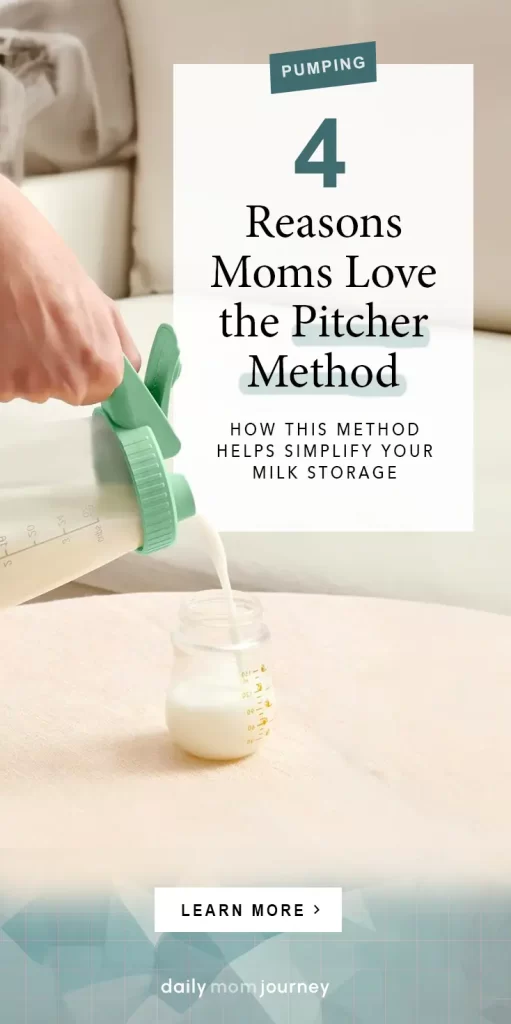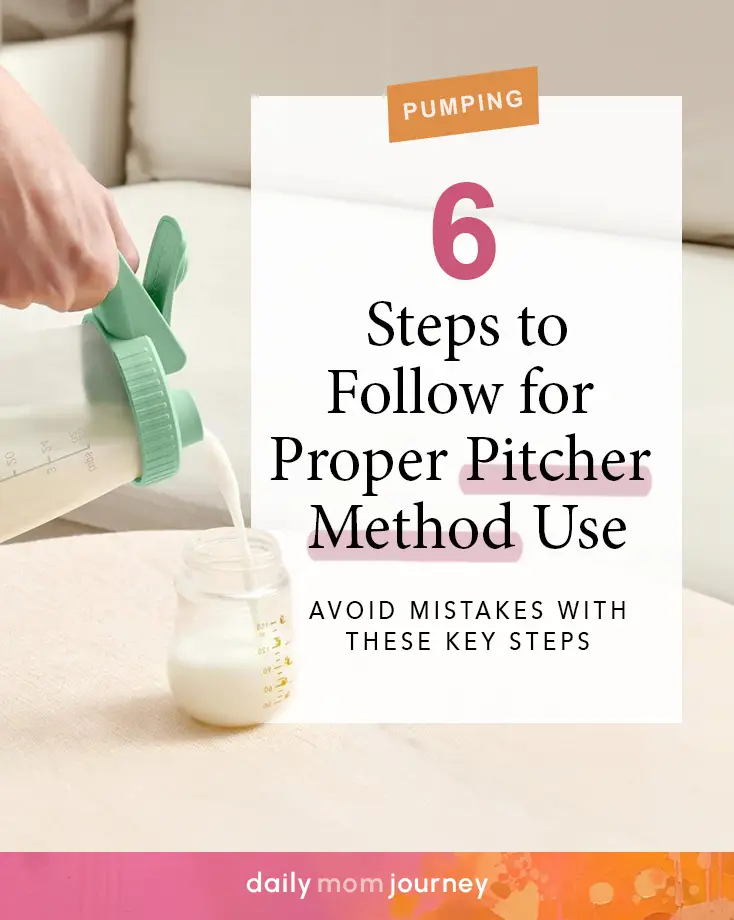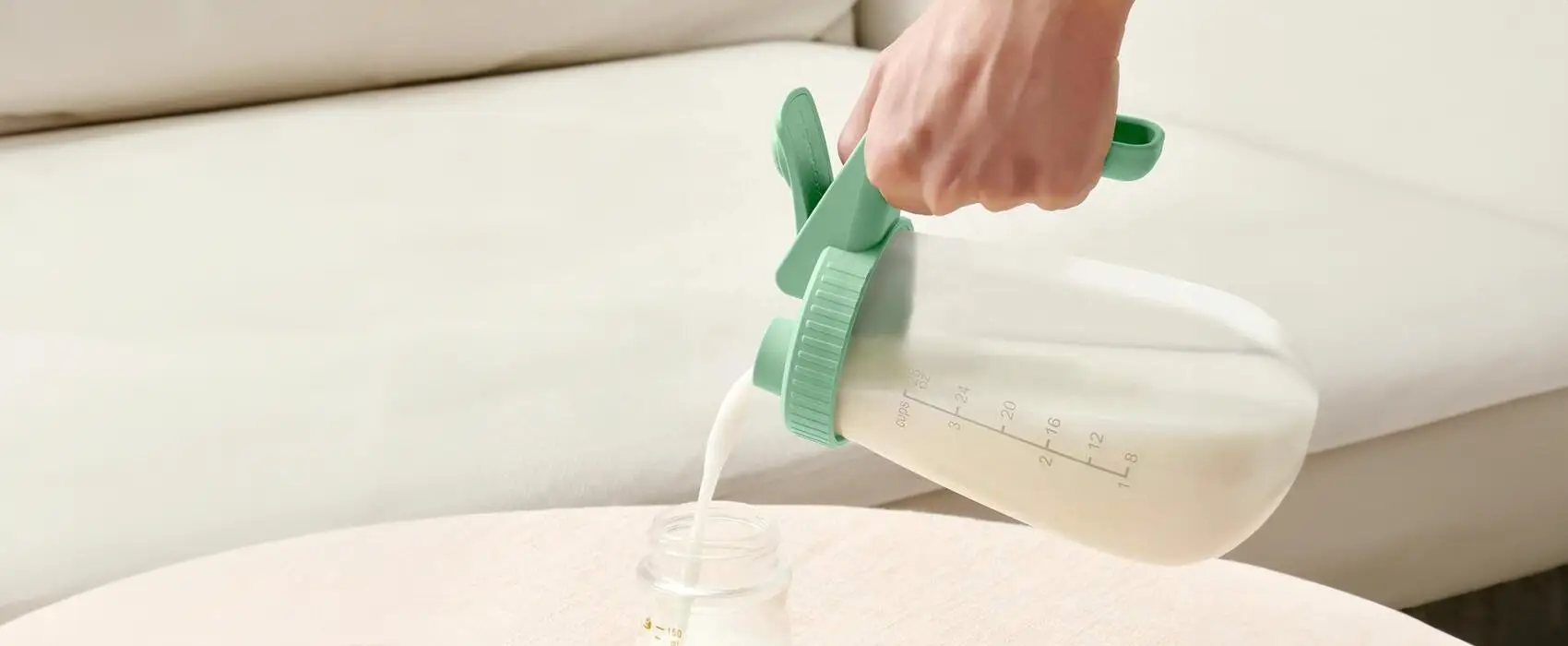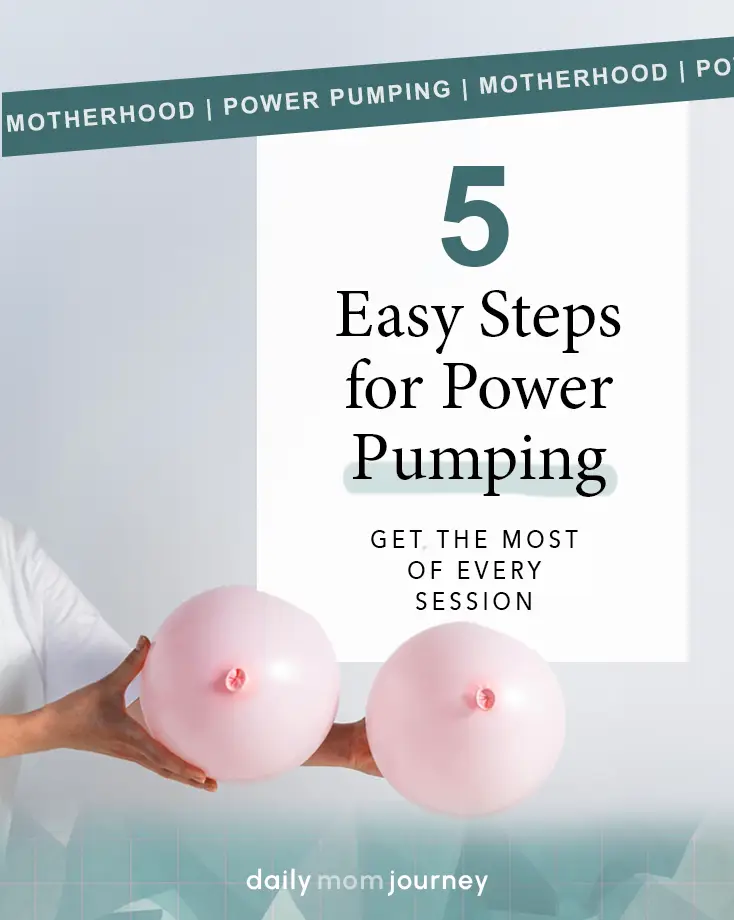Ah, breast pumping. The world where you feel like a dairy cow and a superhero all at once! Whether you’re exclusively pumping or supplementing, managing the milk stash can be a task of its own. Enter: the pitcher method, a storage hack that will have you wondering why you didn’t start sooner.
Let’s dive into what the pitcher method is all about and why so many moms swear by it to streamline their pumping routine.
What is the Pitcher Method?
The pitcher method is a simple, yet brilliant, way to collect and store breast milk throughout the day. Instead of individually freezing every ounce you pump, you pour all of your freshly expressed milk into a single container (like a pitcher or jug) and refrigerate it. By the end of the day, you have one combined batch of milk, which you can either pour into bottles for the next day or freeze in bulk for future use.
Sounds easy, right? That’s because it is!
Related blog post: Breast Pumping Essentials
How Does the Pitcher Method Work?
Here’s the beauty of the pitcher method: it allows you to combine milk from different pumping sessions. Some moms pump a few ounces here and there, while others might fill their bottles after each session. But if you’re collecting smaller amounts, this method ensures nothing goes to waste. Here’s how it typically goes:
- Choose a container: Select a clean, food-safe container to store your milk in. Glass pitchers, BPA-free plastic jugs, or even large mason jars work great. Just make sure it has a secure lid to prevent any spills or contamination.
- Store milk in the fridge: After each pumping session, pour your freshly expressed milk into the pitcher. Place the pitcher back in the fridge to keep it cool. Don’t worry about mixing warm milk with cold milk—experts agree that adding small amounts of freshly pumped milk to refrigerated milk is safe (more on that below!).
- End-of-day (or up to 4 days) sorting: Once you’re done pumping for the day, or up to 4 days after starting the pitcher, you can divide the milk into bottles for the next day or transfer it into freezer bags for long-term storage. Many moms find it helpful to do this daily, but if you’re building a larger stash, waiting up to 4 days works too.
- Label and freeze: If you’re freezing the milk, make sure to label the bags with the date of the first day you started filling the pitcher. This will help you track how long the milk has been stored and ensure it’s used within the recommended time frame.
Pin for later

Milk Storage Guidelines
Whether you’re using the pitcher method or not, it’s important to follow breast milk storage guidelines to keep your milk fresh and safe for your baby. Here’s a quick breakdown of the guidelines for storing breast milk:
- Room temperature: Freshly pumped milk can stay at room temperature (up to 77°F or 25°C) for 4 hours.
- Refrigerator: Breast milk can be stored in the fridge at 40°F (4°C) for up to 4 days.
- Freezer: If you’re freezing your milk, it can be safely stored for up to 6 months, though up to 12 months is considered acceptable in some cases. For best quality, aim to use frozen milk within 6 months.
Be sure to store your milk in clean, sterilized containers or breast milk storage bags, and always label your milk with the date it was pumped to avoid using it past its recommended time frame.
Night vs. Daytime Pumping Sessions: What’s the Difference?
If you’ve been pumping for a while, you’ve probably noticed that your nighttime milk seems a little different than your daytime milk. This is totally normal! Your breast milk naturally changes throughout the day based on your baby’s needs, so combining milk from different times using the pitcher method can offer some great benefits.
- Night milk tends to have higher levels of melatonin, a hormone that helps your baby sleep. It can also contain higher fat content, which keeps your baby feeling fuller at night. If you pump at night and store your milk using the pitcher method, you might notice that it’s creamier and a bit richer.
- Daytime milk is more likely to be lower in fat and has different hormone levels compared to night milk. It’s still nutrient-packed, but it might not have the same sleep-inducing properties as your nighttime milk.
Some moms like to separate their night and day milk when using the pitcher method. For instance, they might have a separate pitcher for nighttime pumping sessions to help with bedtime feeds. This way, you can give your baby the milk that best suits their needs at different times of the day. However, if you don’t have time for that level of organization (because, let’s face it, who does?), don’t worry—combining milk from different times of day is perfectly fine and still gives your baby all the nutrients they need.
Pin for later

Why Moms Love the Pitcher Method
For moms who are pumping multiple times a day, this method is a real time saver. No more scrambling to find multiple bottles or bags, no more losing track of which milk was pumped when, and definitely no more stressing over those precious ounces! Here’s what makes it so great:
- Less hassle: No more scrambling for extra bottles or bags after each pumping session. You can pump and pour directly into your pitcher, minimizing the number of containers cluttering your fridge.
- Reduces waste: With this method, there’s less chance of those precious ounces going to waste. Every drop of milk can be used, especially when combining small pumping sessions.
- Easier bottle prep: Instead of pouring from multiple bottles for feeding, you’ve got one container of milk ready to go. Prepping bottles for the next day is a breeze!
- Saves time: You’re cutting down on the constant chore of cleaning and labeling individual bottles, especially if you pump multiple times a day. Everything is neatly combined in one spot.
How to Safely Use the Pitcher Method
While the pitcher method is a time-saving hack, it’s important to follow a few guidelines to ensure that the milk is safe for your baby:
Glass or plastic?
Many moms prefer using glass pitchers for storage, as they don’t absorb odors and are easier to sterilize. However, BPA-free plastic jugs are just as safe and often lighter and more durable for everyday use.
Sterilize the container
Before using the pitcher, make sure it’s cleaned and sterilized just like any other milk storage container. A good wash with warm, soapy water or a run through the dishwasher will do the trick.
Mixing warm and cold milk
Freshly expressed milk can be added to refrigerated milk, but only in small amounts. As long as the combined milk is promptly refrigerated, there’s no need to worry. According to the CDC and lactation experts, small amounts of warm milk won’t raise the temperature of the cold milk enough to cause bacterial growth.
Pin for later

Stir, don’t shake
After adding your milk to the pitcher throughout the day, give it a gentle stir before pouring it into bottles or freezer bags. Shaking breast milk can break down some of the important proteins and fats, so it’s better to stir gently.
Portioning milk
When preparing bottles or freezing the milk, portion it based on what your baby usually drinks. Freezing in 2-4 ounce portions is recommended, as it prevents waste and makes thawing easier.
Label the milk
If you’re not using the milk immediately, remember to label it. Breast milk can be safely stored in the fridge for up to four days, but you want to ensure that it’s used in a timely manner.
How Long Can You Use the Pitcher Method?
Typically, breast milk can stay in the refrigerator for up to 4 days, and the pitcher method follows that same guideline. Keep track of when you started the batch, and freeze any milk you don’t use within that 4-day window. Freezing extends its life for up to 6 months, which is a lifesaver for building a stash.
Pros of the Pitcher Method
While the pitcher method can be a total game-changer for many pumping moms, like any technique, it has its upsides and potential downsides. Let’s take a closer look at both to help you decide if it’s the right fit for your routine:
Streamlines Storage
One of the biggest advantages of the pitcher method is how it simplifies milk storage. Instead of managing multiple bottles and bags throughout the day, you can pour all your milk into a single pitcher. This eliminates the hassle of tracking and organizing several containers, which can quickly clutter up your fridge. It’s especially helpful for moms who pump frequently and don’t want to deal with an overwhelming number of bottles!
Reduces Milk Waste
If you’re combining smaller pumping sessions into one container, you’re less likely to end up with random tiny amounts of milk that are difficult to store or use. By combining all your milk in a pitcher, every ounce gets used. You can also pour out exactly what your baby needs for a feeding, instead of being stuck with pre-portioned bottles that may end up with leftovers.
Saves Time and Effort
Instead of stopping to label each bottle or bag after every pumping session, you just pop your milk into the pitcher and go on with your day. At the end of the day (or after a few days), you can portion everything out in one go. This also means fewer bottles to wash, fewer bags to handle, and overall less cleaning and organizing. Time saved is always a win in motherhood!
Ideal for Building a Stash
If you’re trying to build a freezer stash, the pitcher method helps you batch-freeze milk efficiently. By combining all your milk in one container, you can freeze in bulk, labeling everything with the same date (the first day you started filling the pitcher). This also makes it easier to organize your milk in the freezer, especially if you’re freezing in consistent portions like 2-4 ounces.
Pin for later

Cons of the Pitcher Method
Risk of Cross-Contamination
One potential downside of the pitcher method is the risk of cross-contamination. Since you’re combining milk from different pumping sessions, there’s a small chance that bacteria from one batch of milk could be introduced to the entire pitcher. To minimize this risk, make sure you’re using clean, sterilized containers and practicing proper hygiene when handling the milk. As long as your pitcher is stored safely in the fridge and used within 4 days, this shouldn’t be a major concern, but it’s something to keep in mind.
Temperature Variations
Some moms worry about mixing warm milk with already refrigerated milk. While lactation experts agree that adding small amounts of warm milk to cold milk is safe as long as the combined milk is promptly refrigerated, this might still be a concern for moms who are extra cautious. One workaround is to let your fresh milk cool in the fridge before adding it to the pitcher. However, this adds an extra step to the process, which could take away from the convenience factor.
Not Ideal for All Moms
The pitcher method works best for moms who pump several times a day. If you’re only pumping once or twice, or if your pumping schedule is sporadic, this method may not be as beneficial. It’s also more effective if you’re pumping larger amounts. For moms who only get small amounts of milk per session, combining those in a pitcher might not feel as productive, and freezing smaller portions immediately might be a better option.
Some Babies Are Sensitive to Taste Changes
Since you’re combining milk from different times of the day, there can be slight variations in the milk’s composition (for example, night milk has higher melatonin). Some babies might notice these subtle changes in flavor or fat content, especially if they’re used to drinking milk from a single pumping session. While most babies adapt just fine, it could be an issue for more particular little ones. If your baby seems sensitive to the taste of combined milk, you may need to adjust your method.
My Experience with the Pitcher Method
I remember when I first heard about the pitcher method from a fellow mom in a Facebook group. At the time, I was pumping every few hours and had a fridge filled with mismatched bottles and bags. I’m talking “Tupperware-level chaos,” where I had no idea which milk was fresh, which had been frozen, or what I needed to use first. I was on the verge of losing it.
Once I tried the pitcher method, I was hooked. Instead of scrambling through bottles at midnight, I had one neat container of milk that made the entire feeding process more manageable. And trust me, when you’re sleep-deprived and just trying to survive, every little thing that simplifies your life is a win.
Q&A: All Your Questions about the Pitcher Method Answered
Can I mix milk from different pumping sessions?
Absolutely! The whole idea of the pitcher method is to combine your milk from different times of day. Just ensure you’re storing the pitcher in the fridge as you go.
What kind of container should I use for the pitcher method?
You can use any clean, food-safe container. Many moms love using glass pitchers, but plastic jugs (BPA-free) or even large mason jars work too.
Is it safe to mix warm milk with cold milk?
Yes, in small amounts, it’s fine. Freshly pumped milk can be added to refrigerated milk as long as you refrigerate the combined milk promptly.
How long can breast milk stay in the pitcher?
Breast milk can stay in the refrigerator for up to 4 days. Be sure to freeze any unused milk before the 4-day mark.
Does the pitcher method save time?
Yes! Instead of freezing or bottling each pump session, you deal with it all at once, making the process quicker and more efficient.
The pitcher method is truly a game-changer for busy pumping moms. It’s all about finding ways to make your life easier, and this method does just that. Whether you’re a newbie to the pumping world or a seasoned pro, give it a try—you might just fall in love with the simplicity!
Shop our Amazon favorites















